Partial denture 1

Mastering Partial Dentures Quiz
Test your knowledge on partial dentures with our comprehensive quiz! This engaging and educational quiz consists of 101 carefully crafted questions that cover a wide range of topics essential for dental professionals and students alike.
Challenge yourself with questions on:
- Clasp designs and applications
- Major connector fun
ctions and requirements - Mandibular and maxillary anatomy
- Rest preparation techniques
Infrabulge clasps originate:
above the 12mm undercut areas
above the occlusal surface of most premolars
above the height of contour
below the height of contour
Reciprocation between bracing and retentive components requires:
I bars be used
Aker clasp be used
Bracing components contacts after retentive components
Correct timing of contact during seating and removed of RPD
The basic movement of mandible:
hinge movement
hinge movement
lateral movement
hinge ,lateral and translatory movement
Maxillary major connectors most common use is:
full palatal strap
palatal strap
anterior posterior palatal strap
anterior palatal strap
Anterior posterior palatal strap especially use is:
maximum rigidity
maximum bulk
use in most cases
torus palatal
Which of the following maxillary major connectors possesses the least strength and rigidity?:
anterior posterior palatal strap
palatal plate
horse –shoe
modified palatal strap
Which of the following clasps commonly utilize lingual undercut?:
Extended arm clasp
Back action clasp
Embrasure clasp
Ring clasp
The external finish line is:
the external of framework metal and denture base plastic
the external of framework metal and supporting tissues
the external of framework metal and the natural teeth
the external of the natural teeth and the denture base plastic
. Functions of a Major connector:
component of RPD connect to acrylic resin
kind of metal chrome cobalt
functions as one unit
unification, stress distribution, cross arch stabilization
Requirements of a Major connector:
connects various parts
distributes functional loads to both teeth and mucosa
partial denture acts as one unit
rigidity, non interference with tissues, minimize food impaction and unobtrusive
The superior border of mandibular lingual bar major connector should be:
at least 3mm from the tooth/ tissue junction
at least 3mm from the tooth/ junction
as far from gingival margin as possible
at least 3mm above the tooth/ junction
. The internal finish line is:
the butt joint between the metal and resin acrylic on the tissue side of the edentulous area
the butt joint between the metal and resin acrylic on the outer surface of the RPD
a type of posterior palatal seal
a special type of above
. A combination clasp assembly generally has:
a bracing arm , a retentive arm and rests
a retentive arm ,rests and indirect retainer
rests, a retentive arm and proximal plate
rests , a bracing arm and proximal plate
The external finish line on a maxillary class 1 RPD originates from the lingual of the guide plane of the terminal abutment and ends:
at the hamular notch
in the glenoid fossa
opposite the buccal pouch
opposite stenon’s duct
The Gridwork of Minor Connector on a maxillary class 1 RPD:
covers the hamular notch
covers the tuberosity
does not cover the tuberosity
covers the crest and tuberosity
. Occlusal rest preparation should be:
spoon shaped, at least1/3 the bucco lingual width of the occlusal surface, at least 1m deep
flat shaped, at least1/3 the bucco lingual width of the occlusal surface, at least 1mm deep
pear shaped, at least 1/2 the bucco lingual width of the occlusal surface, at least 15mm deep
teardrop shaped, at least 1/2 the bucco lingual width of the occlusal surface, at least 15mm deep
A lingual plate major connector may be selected be cause
the mandibular incisors are tilted lingually, mandibular tori present, high lingual frenum
the mandibular incisors are tilted facially, high floor of the mouth
the mandibular incisors are tilted facially, mandibular tori present ,high lingual fremum
The mandibular incisors are tilted lingually ,high floor of the mouth, high lingual frenum
. An anterior posterior palatal strap major connector is less rigid than a horseshoe major connector because it (the AP strap) has less width:
The first statement is true but the reason is false
The first statement is false and the reason is also false
The first statement is true and the reason is true
The first statement is false but the reason is true
In a circumferential clasp assembly, the arms may extend into an undercut:
The bracing arm
The reciprocating arm and retentive arm
The bracing arm and retentive arm
The retentive arm
Which of the following steps is done LAST ?:
Rest preparation
Framework try in
Centric relation records
Altered cast impression
Direct retainer (clasps):
help stabilize the RPD by controlling occlusal movement
Help stabilize the RPD by controlling gingival movement
may also function as indirect retainers
prevent excessive biting forces on the abutment
What are the indications for a linguo plate as a major connector for a mandibular RPD?:
Present high floor of the mouth and facially anterior teeth
Present high lingual frenum and buccally anterior teeth
Present lingual tori and big tongue
High floor of the mouth, high lingual frenum, lingual tori
Incisal rests should generally not used on maxillary incisors Why?:
for mandibular class 4 kennedy only
For maxillary class 4 kennedy only
for maxillary and mandibular class 1 and 2 kennedy
poor esthetics and interferences with opposing occlusion
Component of a clasp assembly are:
One rest, a retentive arm , a bracing or reciprocating element, one minor connector
One or two rests, a retentive arm, a bracing or reciprocating element, one minor connectors, one major connector
One minor connector, one major connector, one rest, two rests, one retentive arm, one bracing arm
Two minor connectors, one major connector , one rest, one retentive arm, one bracing or reciprocating element
The basic philosophy of dental treatment for a partially edentulous patient:
Preserve what remains and restore what is missing
Replace the missing teeth
Improve the path of insertion
Reshape rotated teeth
Full palatal plate:
Minimum tissue support
Connector of choice in short distal extension cases
Six or more anterior teeth remain
Six or less anterior teeth remain
Maximum tissue support , connector long distal extension cases, six or less anterior teeth remain
Physiologic Rest is a position of vertical dimension which can be recorded with:
Centric relation
Centric occlusion or MIP
Edge to edge incisor contact
Posselt’s envelope
A jaw which is moving in a ”left or right” motion would be called what type of movement:
lateral pure hinge
lateral protrusion
Lateral
horizontally protrusive
The condyle on the working side is called the working condyle, which is also known as the:
orbiting condyle
balancing condyle
rotating condyle
translatory condyle
Considering the design of an RPD for the mandibular arch…:
Survey crowns should be done to correct the mesial tilt of the molar
Retentive clasps are required next to each edentulous space
The lingual plate would be the major connector of space
Dual path of insertion should be considered
Which one of the following Kennedy classes of RPD, never has an axis of rotation?:
class I of Kennedy
class II of Kennedy
class III of Kennedy
class IV of Kennedy
Cleaning a removable partial denture in sodium hypochlorite may result in:
increased caries activity
increased periodontal problems
whitening acrylic resin and artificial teeth
corrosion of the metal the framework
During biting a maxillary class I RPD with rotate around a line determined by the rigid metal above the survey line and closed to the extension areas This line is called:
Dual path line
Frankfurt line
Camper’s line
Axis of rotation
Mandibular gridwork design of minor connectors:
Maximum bulk of the acrylic resin
Prevents thin, edges fracturing
Extend fully to the hamular notch
extend 2/3 of the way from abutment tooth to retromolar pad
. The correct answer the basic movements of the mandible:
Hinge, chewing and yawing
Translatory movements relative to centric relation
Lateral, dimension, excursion
Hinge , lateral and translatory movement
A mandibular movement which is<< either opening or closing motions of the mandible around a horizontal axis that is common to both condyles >> would be best classified as a…………movement:
translatory excursion
centric relation
Lateral
Hinge
Protrusive or Retrusive movements can also be called………………movement:
translatory or vertica
translatory or shifting
translatory or sliding
sliding crossbite excursions
When the survey line is height on the Mesial or Distal but low on the center, which one design clasp:
I clasp
Y clasp
T clasp
U clasp
More acceptable esthetically and less caries formation for bar clasp is:
Y clasp
I clasp
T clasp
U clasp
Est selection of preventing abutments tooth of class I Kennedy from the negative effects of the additional load applied to them is by:
Splinting abutment with adjacent teeth
Placing distal rests on the distal abutment
Keeping a light occlusion on the distal extensions
Regular relining of distal extensions
When designing palatal connectors, relief should be given for:
Ridge area
Elevated mid suture line
Rugae area
Palatal torus
For the preparation of rest seat:
Marginal ridge should be reduced by 25 mm
Marginal ridge should be reduced by 1 mm
The outline to have greater length than width
The outline to have greater width than length
Which of the following chronic conditions may cause tooth abrasion?:
Pipe smoking
Occlusion trauma
Hard brush using and strong brushing
Strong mastication
Tripod of dental surveyor is the method used:
For giving clasp assemblies at 3 points
Determine the undercut areas on the tooth
Surveyor to have reproducible position of the cast on the surveyor
Surveyor for recording the relation of the cast to the surveyor
What are the typical positions of the maxillary and mandibular teeth, and the tongue during empty mouth swallowing?:
Centric occlusion, the tongue touches the palate
Occlusion, the tongue touches the lingual aspects of the anterior teeth
Retruded contact, the tongue touches the palate
Retruded contact, the tongue touches the lingual aspects of the anterior teeth
Mesh type of grid work minor connectors is:
Potentially superior retention
Interferes with setting of teeth
Struts are too thick
Potentially more rigid
Lattice type of grid work minor connectors is:
Flatter
Potentially more rigid
Less retention for acrylic resin
Potentially superior retention
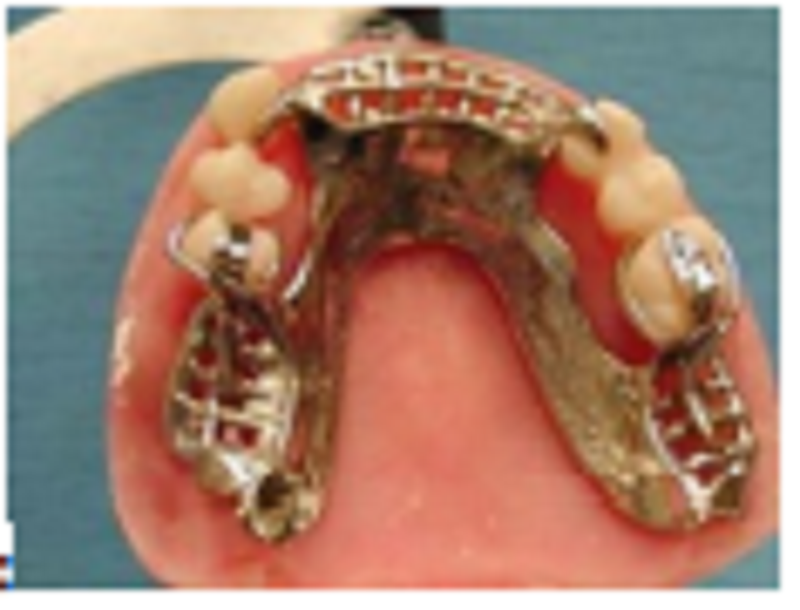
The kennedy classification of this RPD is
class IV mod II
class II mod I
class I mod II
Class I mod I
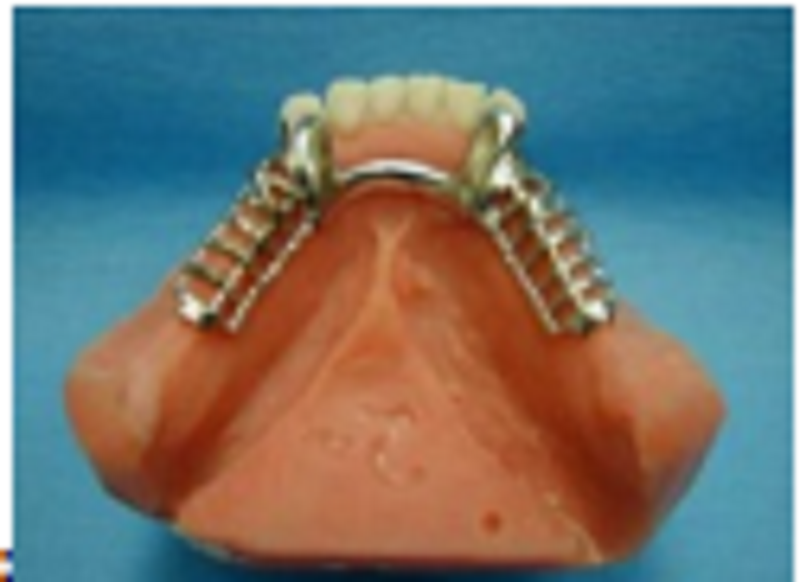
The kennedy classification of this RPD is:
Kennedy class II
Kennedy class I
Kennedy class I mod I
kennedy class II mod I
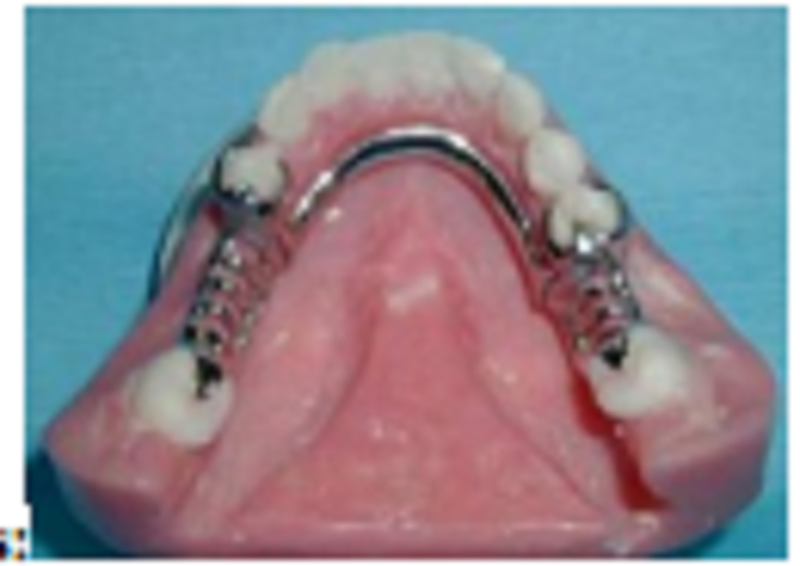
The Kennedy classification of this RPD is:
Kennedy class III
Kennedy class III mod I
Kennedy class IV mod I
Kennedy class II mod I
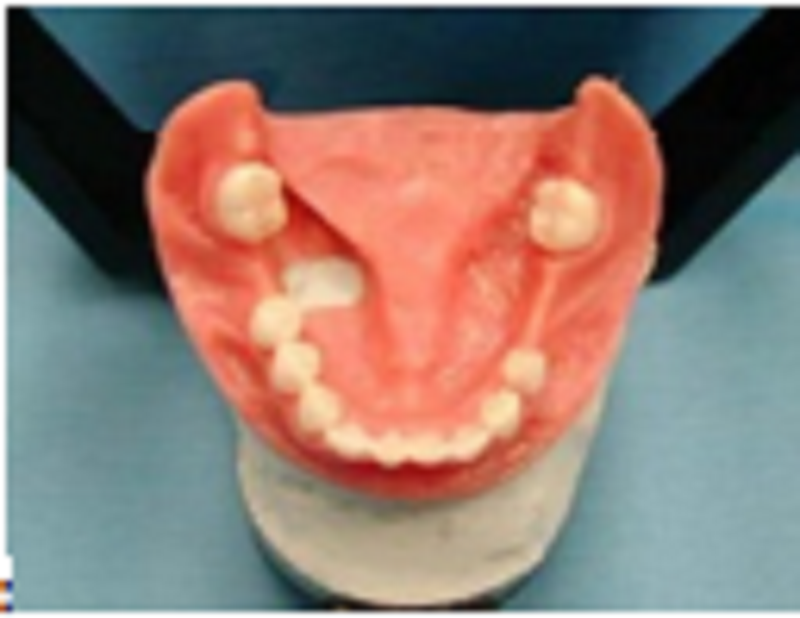
The Kennedy Classification for this cast is:
Class III mod I
class III mod II
class III
class III mod III
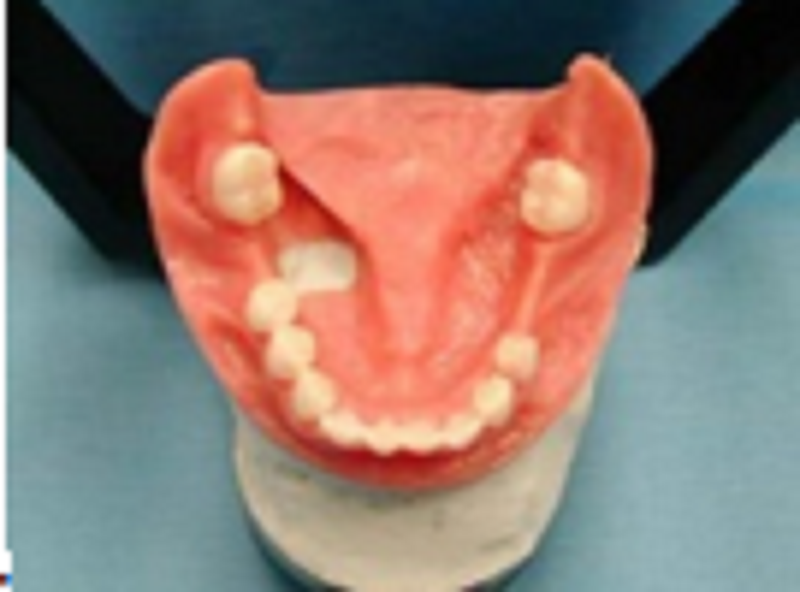
Considering the design of an RPD for the mandibular arch
Survey crowns should be done to correct the mesial tilt of the molars
Retentive clasps are required next to each edentulous space
The lingual plate would be the major connector of space
A dual path of insertion should be considered

What is a RPD component is not needed in this type of case?:
Major connector
Guide planes
Direct retainers
Indirect retainers
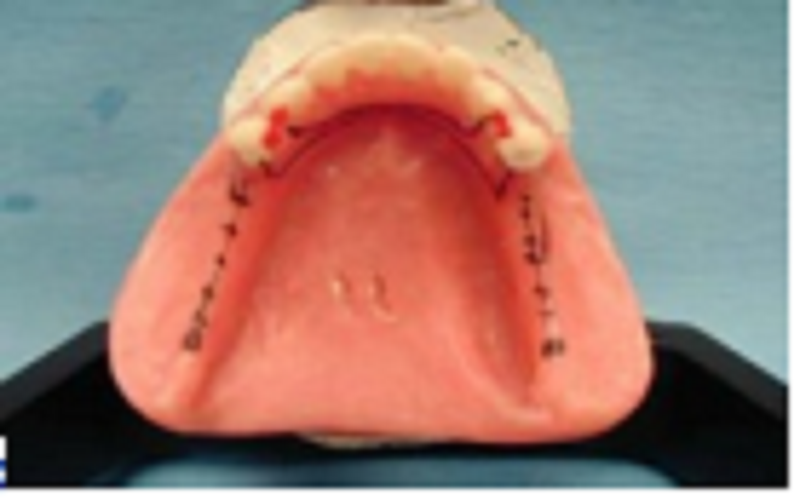
If this RPD was fabricated exactly as drawn on the design cast, which component(s) would be nadequate?:
Minor connectors
lingual bar
Direct and Indirect retainers
All are correct
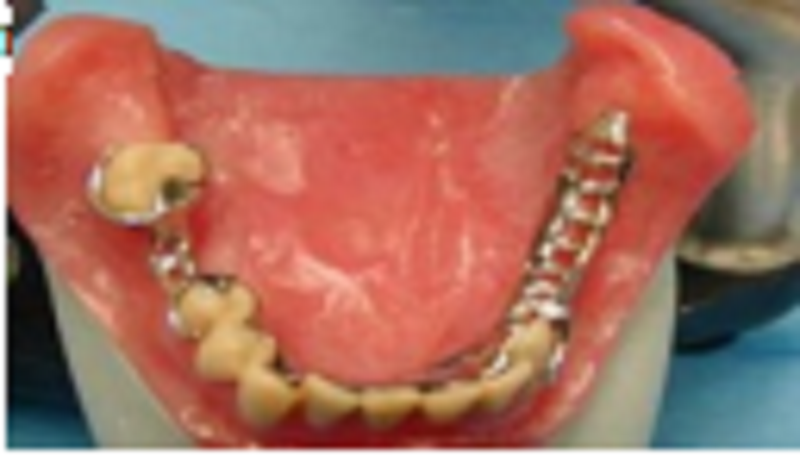
The denture base acrylic resin minor connector on the patient’s left side should correctly be located:
2/3 to ½ the length of the residual ridge
On the retromolar pad
1/3 the length of the residual ridge
Have a mesh acrylic retention area
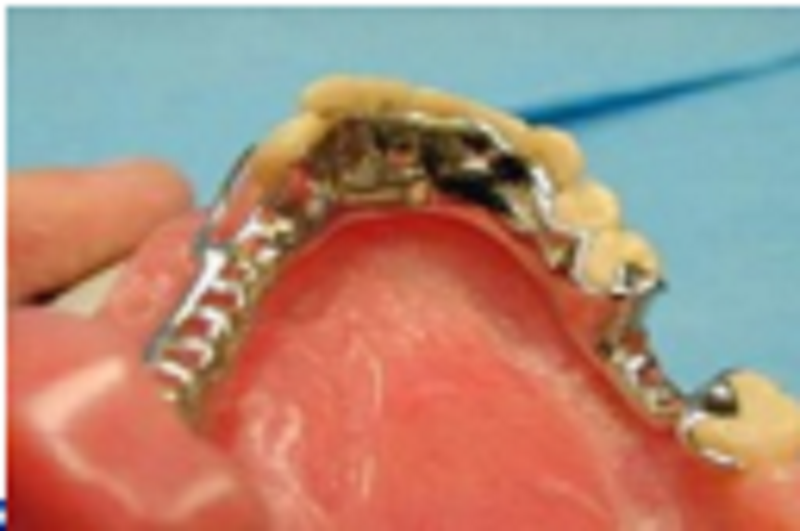
The external finish lines on this framework are:
Indistinct
Would allow for acrylic and meta
too deep or over contoured
Correct
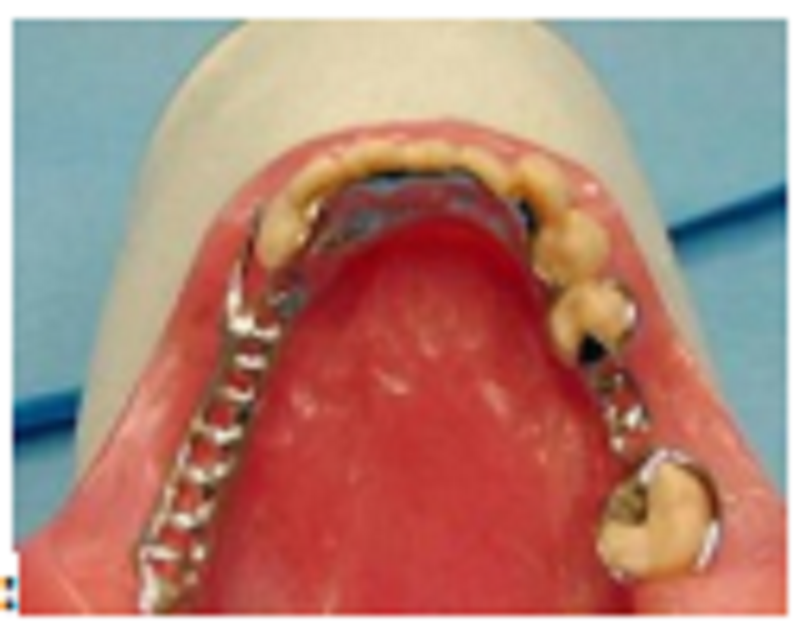
The superior border of this major connector:
Is not acceptably adapted to the teeth
Is correctly adapted to the teeth
is too low
is too small
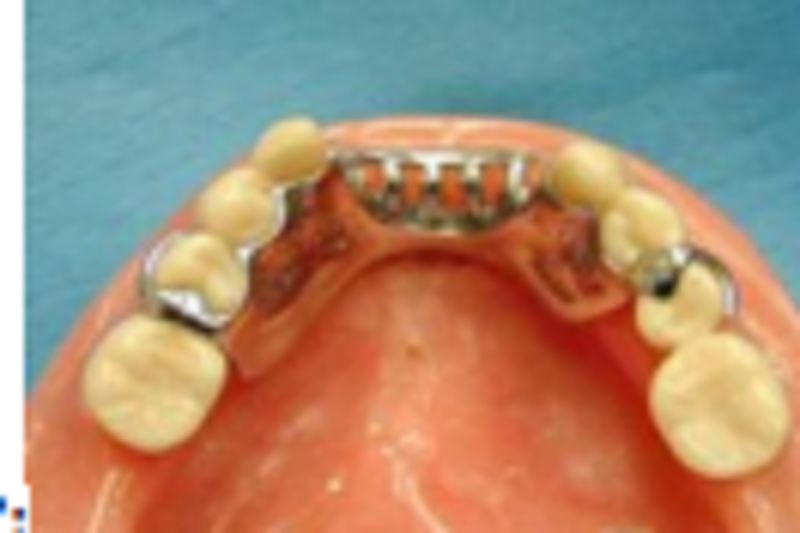
Which of the following is missing from the clasp on #45?:
Minor connector
Rest
Reciprocating arm
Retentive clasp arm
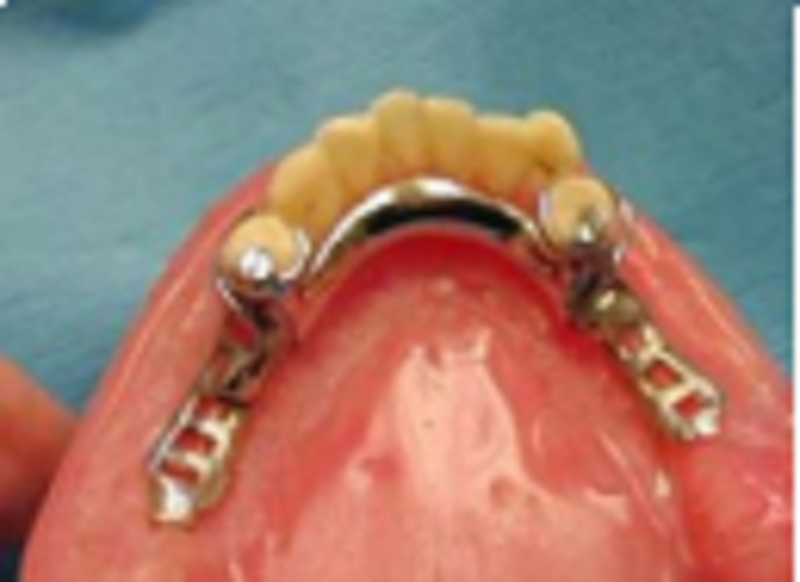
The major connector in this mandibular class I removable partial denture:
Is to long occlusal gingivally
Is too close to the free gingival margin
Is missing an indirect retainer
All are correct
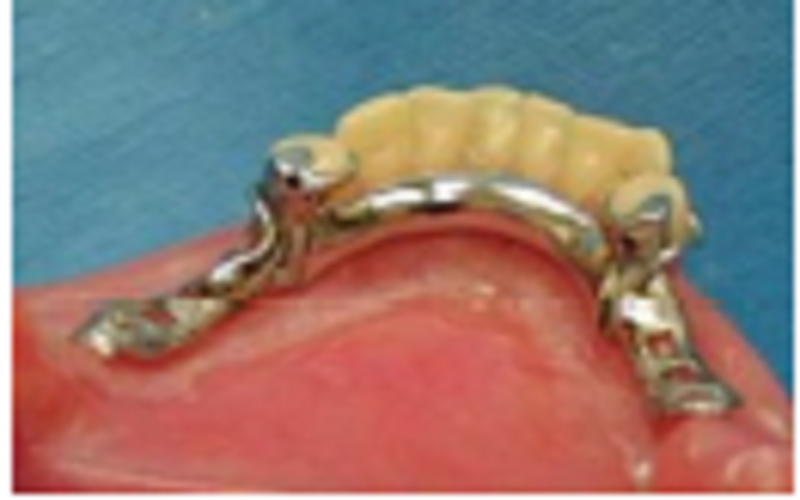
The major connector in this mandibular class I removable partial denture:
Is a lingual bar and its superior border is too close to the free gingival margins
Is a lingual bar and its superior border is placed correctly
Is a lingual bar and the placement of the superior border of the lingual bar is of no importance to the soft tissues
Is a lingual bar too short and too close the free gingival margin
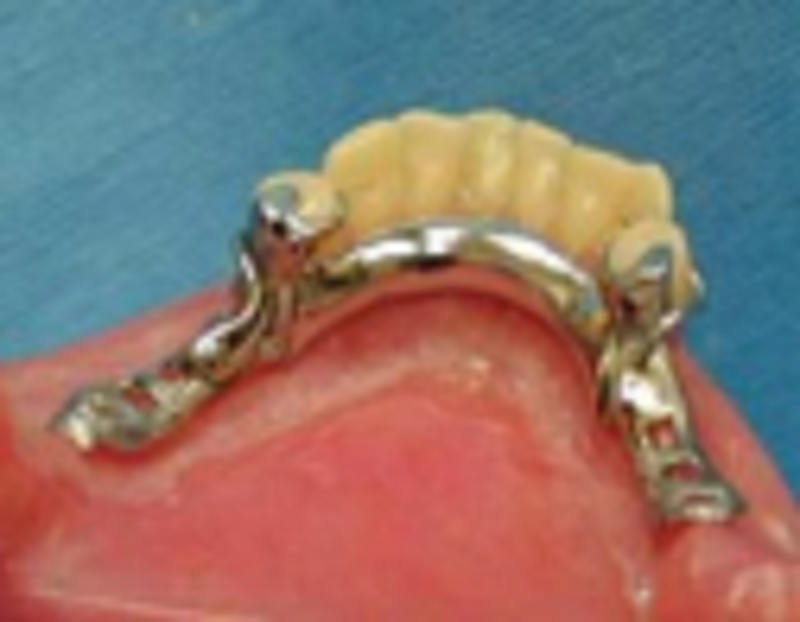
In this Class I mandibular removable partial denture, rests preparations on the cingulum of (#33+):
Would provide indirect retention for the removable partial denture if covered by the major connector
Would provide indirect retention for the removable partial denture
Are not indicated in this case
Are correct if rests preparations are good
A lingual plate major connector may be selected be cause:
the mandibular incisors are tilted lingually
there are mandibular tori present
there is a high lingual frenum
All are correct
Occlusal rest preparation should be:
spoon shaped
at least 1/3 the bucco lingual width of the occlusal surface
At least one millimetre deep
All are correct
Incisal rests:
a generally more positive vertical stops than cingulum rests
may interfere with the opposing occlusion
Hould not be used on maxillary incisors
All are correct
In which of the following mandibular positions are the teeth in contact?
Centric Relation and Centric Occlusion
Edge to Edge Incisor Contact
Maximum Mandibular Protrusion
Negative, Horizontal and Vertical Overlaps at incisors
All are correct
A clasp assembly should:
have a retentive arm with adequate length and taper for flexibility
have a retentive arm that terminates in an undercut
have elements that considered together provide 180 degree encirclement
All are correct
Reason (s) for selecting lingual plate major connectors is/are?:
the presence of lingual tori
Anticipated loss of one or more of the remaining teeth
A high lingual frenum
All are correct
Indication of Removable Partial Denture:
Large edentulous space, deep undercut of abutment, not posterior of abutment
Periodontitis of abutment, esthetic for posterior tooth, not posterior of abutment
Large edentulous space, not posterior of abutment, periodontitis of abutment
Deep undercut of abutment, periodontitis of abutment, not posterior of abutment
. An ideal design framework of RPD should be:
Determine the path of insertion
As guiding planes
Locate retention areas
Locate the height of contour
All are correct
An ideal design a major connector should possess the following qualities:
Unification
Stress distribution
Cross Arch stabilization
Rigidity
All are correct
. The diagnosis of master cast of RPD be for design framework should be:
Determine path of insertion
Determine high of contour
Determine parallelism of abutments
Determine guiding planes
All are correct
. The goal of extension of RPD framework should be:
Stability framework
Function, Occlusion
Tissues adaptation
All are correct
The function of the guide plate is to:
Help establish a definitive path of insertion/ dislodgement
Stabilize the RPD by controlling its horizontal position
Stabilize the RPD by controlling its horizontal position
All are correct
What would be the best denture base connectors when there is limited inter occlusal space (<3mm):
Open lattice type
Mesh type
All metal base
All plastic base
All of the following clasps are infrabulge clasps except ?:
Ibar
Modified T bar
Roach clasp
Akers clasp
. Which of the following clasps commonly utilize lingual undercut ?:
Ring clasp , I bar clasp
Extended arm clasp, Akers clasps
Half and half clasp, Back action clasp
Half and half clasp, Ring clasp
A cingulum rest should be placed:
Between the occlusal and middle thirds of the incisors teeth
Above the middle third of the incisor teeth
On the disto incisal edges of the incisor teeth
At the junction of the gingival and middle thirds of the incisor teeth
An area undercut may preclude the selection of :
A suprabulge clasp
An infrabulge clasp
A Half and half clasp
A combination clasp
A removable partial denture may be:
All tooth supported
Tooth and tissue supported
All tooth supported and tissue supported
All tissue supported
Following condition(s) is/are also called as distal extension partial denture:
Kennedy’s class IV
Applegate class VI
Kennedy’s class I
Applegate class V
Following structure of RPD gives both occlusal support and horizontal stabilization:
Occlusal rest
Interproximal occlusal rest
Internal occlusal rest
Indirect retainer
Removable partial denture movements away from tissue may occur due to following except:
Pull of food
Moving border tissues
Gravity
Mastication
Parts that offer support for removable partial denture are following:
Rest and reciprocal arm
Rest and retentive arm
Rest and denture base
Rest and minor connector
. Denture bases of removable partial denture offer:
Primary retention
Mechanical retention
Primary and mechanical retention
Secondary retention
In distal extension denture base, when there is no modification area exists on opposite side of the arch a………clasp is suitable at that side:
Ring clasp
Back action clasp
Reverse circumferential clasp
Embrasure clasp
Multiple clasps are joined at :
Tip of retentive terminals
Tip of reciprocal terminals
Back of occlusal rests
Back of the minor connector
Following parts of a removable partial denture may act as indirect retainer, except:
Rests
Proximal plates
Minor connector supporting rests
Retentive tip
When designing palatal major connectors ,relief should for:
Palatal torus
Ridge area
Elevated mid suture line
Pugae areas
Labial bar is indicated when:
There is a diastema
There is labial inclination of teeth
There is linqual inclination of teeth
There are periodontally weak teeth
The superior border of linqual bar should be:
Deep in the linqual sulcus
At least 4 mm below the gingival margin
At the cingulum of anterior teeth
At least 7 mm below the gingival margin
What are the functions of an indirect retainer:
to prevent horizontal dislodgement of the distal extension bases of removable partial denture.
to connect the parts of the prosthesis located on one side of the arch with those on the opposite side
to prevent vertical dislodgement of the distal extension base of removable partial denture.
to link the major connector and other parts of the prosthesis together
In the mesial rest, guide plane and i-bar design, reciprocation is achieved by:
flexible plating
flexible plating
major connectors
Retentive clasp arm
All of the following are advantages of the gingivally approaching clasps as compared to occlusally approaching clasps, except:
less tooth contact
less distortion of coronal contours
less bothersome to vestibular tissues
Esthetically superior in most cases
. Stability is mainly against:
horizontal forces
functional forces
horizontal forces and functional forces
forces against removal of prosthesis
An undercut in relation to tooth lies:
below the survey line
above the survey line also
below the survey line and above the survey line also
on occlusal surface
{"name":"Partial denture 1", "url":"https://www.supersurvey.com/QPREVIEW","txt":"Test your knowledge on partial dentures with our comprehensive quiz! This engaging and educational quiz consists of 101 carefully crafted questions that cover a wide range of topics essential for dental professionals and students alike.Challenge yourself with questions on:Clasp designs and applicationsMajor connector functions and requirementsMandibular and maxillary anatomyRest preparation techniques","img":"https:/images/course3.png"}
More Surveys
Partial Denture 2
763825
Complete Denture 2 (សូមមេត្តាកុំចែកចាយ Link ដោយគ្មានការអនុញ្ញាត)
60300
Fix Prostodontic 5
60300
Endodontics II 2 Dr.Khoeung RathVisal
502538
MCQ orthodontic mey phoung1
502531
Periodontology
5025378
Periodontology
4724465
Periodontology
5326661
Endodontics
6030403
Endodontic II Dr.Khoeung Rath Visal
502541
Complete Denture 1 សូមមេត្តាកុំចែកចាយ Link ដោយគ្មានការអនុញ្ញាត
60300
Periodontology
6030446